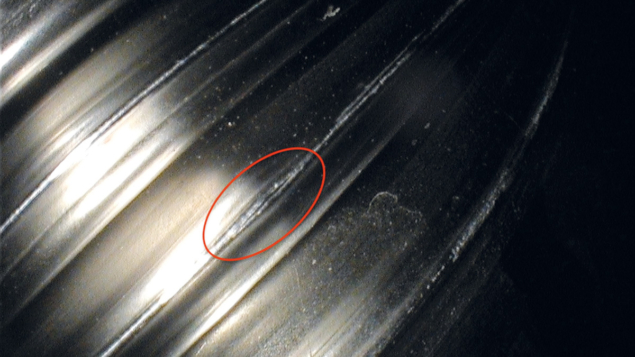
1.6 mm-long crack (circled) in one of the LHC’s compensation bellows. Credit: CERN/EN-MME-MM
At around 1 a.m. on 17 July, the LHC beams were dumped after only nine minutes in collision due to a radiofrequency interlock caused by an electrical perturbation. Approximately 300 milliseconds after the beams were cleanly dumped, several superconducting magnets lost their superconducting state, or quenched. Among them were the inner-triplet magnets located to the left of Point 8, which focus the beams for the LHCb experiment. While occasional quenches of some LHC magnets are to be expected, the large forces resulting from this particular event led to a breach of the vacuum helium pressure vessel, rapidly degrading the insulation vacuum and prompting a series of interventions with implications for the 2023 Run 3 schedule.
The leak occurred between the LHC’s cryogenic circuit, which contains the liquid helium, and the insulation vacuum that separates the cold magnet from the warm outer vessel (the cryostat) – a crucial barrier for preventing heat transfer from the surrounding LHC tunnel to the interior of the cryostat. As a result of the leak, the insulation vacuum filled with helium gas, cooling down the cryostat and causing condensation to form and freeze on the outside.
By 24 July the CERN teams had traced the leak to a crack in one of more than 2500 bellows that compensate for thermal expansion and contraction on the cryogenic distribution lines. Measuring just 1.6 mm long, it is thought to have been caused by a sudden increase in vacuum pressure when the magnet quench protection system (QPS) kicked in. Following the electrical perturbation, the QPS had dutifully triggered the quench heaters (which are designed to bring the whole magnet out of the superconducting state in a controlled and homogenous manner) of the magnets concerned, generating a heat wave according to expectations.
It is the first time that such a breach event has occurred; the teamwork between many working groups, including safety, accelerator operations, vacuum, cryogenics, magnets, survey, beam instrumentation, machine protection, electrical quality assurance as well as material and mechanical engineering, made a quick assessment and action plan possible. On 25 July the affected bellow was removed. A new bellow was installed on 28 July, the affected modules were closed, and the insulation vacuum was pumped.
The electrical perturbation turned out to be caused by an uprooted tree falling on power lines in the nearby Swiss municipality of Morges. In early August, as the Courier went to press, the repairs were finished and the implications for Run physics were being assessed. The choice is between preparing the machine for a short-term proton–proton phase to account for some of the missed run time or sticking to the planned heavy-ion run at the end of the run year, since in 2022 there was no full heavy-ion run. The favoured scenario is to go with the latter and was presented to the LHC machine committee on 26 July.








